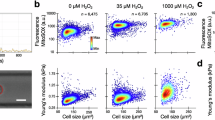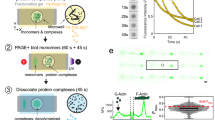Abstract
When cells are first exposed to low levels of oxidative stress, they develop a resistance to a subsequent challenge of the same stress, even at higher levels. Although some protein(s) induced by oxidative stress likely mediated this adaptive response, the nature of these proteins is unknown. In this study, the total proteins extracted from human U937 leukemia cells exposed to 50 µM H2O2 for 24 h to induce an optimal protective response were analyzed by two-dimensional polyacrylamide gel electrophoresis. H2O2 treatment induced elevation of level of 34 protein spots. An analysis of these spots by a matrix associated laser desorption/ionization time-of-flight mass spectrometry identified 28 of the H2O2-induced proteins. These include proteins involved in energy metabolism, translation and RNA processing, chaperoning or mediating protein folding, cellular signaling, and redox regulation, as well as a mitochondrial channel component, and an actin-bundling protein. Therefore, it appears that the cellular adaptation to oxidative stress is a complex process, and is accompanied by a modulation of diverse cellular functions.
Similar content being viewed by others
Article PDF
Author information
Authors and Affiliations
Rights and permissions
This is an Open Access article distributed under the terms of the Creative Commons Attribution Non-Commercial License (http://creativecommons.org/licenses/by-nc/3.0/) which permits unrestricted non-commercial use, distribution, and reproduction in any medium, provided the original work is properly cited.
About this article
Cite this article
Seong, J., Kim, D., Choi, K. et al. Proteomic analysis of the cellular proteins induced by adaptive concentrations of hydrogen peroxide in human U937 cells. Exp Mol Med 34, 374–378 (2002). https://doi.org/10.1038/emm.2002.53
Published:
Issue date:
DOI: https://doi.org/10.1038/emm.2002.53
Keywords
This article is cited by
-
Mutations in the RAM network confer resistance to the thiol oxidant 4,4′-dipyridyl disulfide
Molecular Genetics and Genomics (2008)
-
Tissue factor as an effector of angiogenesis and tumor progression in hematological malignancies
Leukemia (2006)



